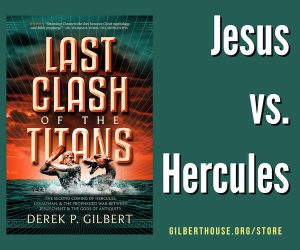One of the most intriguing mysteries in the Bible is the identity of Gog of Magog. Let us state for the record, with all due respect, that most scholars and students of end-times prophecy are looking in the wrong place for an answer.
We don’t mean just geographically; we mean in the wrong plane of existence. Gog will not be human.
A human actor will be involved, no question. But the one who drives the action—or, more accurately, is led into action, since he’s dragged by hooks in his jaw, is supernatural. And it’s easier to identify him with some confidence than to guess whether Gog is Vladimir Putin, Recep Tayyip Erdogan, or some other political leader in the Middle East.
First, historical context. The prophet Ezekiel wrote his book while living as an exile in greater Babylonia beginning around 593 BC. He was among the first group of captives taken from Judah by Nebuchadnezzar, the Chaldean king of Babylon. From the first chapter of his book, we learn that he lived along the Chebar canal, which diverted water from the Euphrates River near Babylon through the city of Nippur. This was in what is now Iraq, about a hundred miles southeast of modern Baghdad.
God put nothing in the Bible that isn’t relevant. What seem like minor details prove to be very important when we understand the context. If something looks unimportant, it’s probably because we just don’t understand it correctly. Or, in the words of the late Dr. Michael Heiser, “If it’s in the Bible and it’s weird, it’s probably important.”
So it is with Ezekiel’s location. The Chebar canal is only mentioned by Ezekiel, but he saw fit to mention it eight times. It was where he saw several visions from God, including the famous one that has UFO believers so needlessly excited, Ezekiel’s wheel.[1]
His home was Tel Abib, a community that gave its name to the second-largest city in modern Israel, Tel Aviv (spelled differently but pronounced the same). Nearby Nippur was one of the most important religious sites in the ancient Near East, the holy city of the god Enlil and the home of his temple, the E-kur (“House of the Mountain”). As we have noted elsewhere, Enlil was the chief god in the Mesopotamian pantheon for centuries. He replaced the sky-god, Anu, and was in turn replaced as king of the gods by the city god of Babylon, Marduk.
Nippur, or Nibru in Sumerian, was where ancient Sumerians and Akkadians believed the gods met—the location of their divine council. Beginning in the late 1960s, authors like Erich von Däniken and Zecharia Sitchin, inspired by writers like horror fiction author H. P. Lovecraft,[2] tortured the texts of the ancients to support their belief that the chief gods of Sumer, the Anunnaki (before they were demoted to the netherworld—part of their story the “ancient aliens” crowd either don’t mention or simply don’t know), arrived on Earth hundreds of thousands of years ago from a planet called Nibiru, whereupon they created humanity through genetic engineering to serve as slaves.
The irony is that the nonsense peddled by ancient astronaut theorists pales in comparison to the truth. The reality is way more interesting! God called Ezekiel, revealed His glory, and delivered to the prophet foreknowledge of the end times directly above the temple of the chief god of Mesopotamia.
Coincidence? Not a chance.
Ezekiel’s visions of the war of Gog and Magog is where Bible prophecy meets Greek myth. So, let’s dig in:
The word of the LORD came to me: “Son of man, set your face toward Gog, of the land of Magog, the chief prince of Meshech and Tubal, and prophesy against him and say, Thus says the Lord GOD: Behold, I am against you, O Gog, chief prince of Meshech and Tubal. And I will turn you about and put hooks into your jaws, and I will bring you out, and all your army, horses and horsemen, all of them clothed in full armor, a great host, all of them with buckler and shield, wielding swords. Persia, Cush, and Put are with them, all of them with shield and helmet; Gomer and all his hordes; Beth-togarmah from the uttermost parts of the north with all his hordes—many peoples are with you.
Ezekiel 38:1–6, ESV
Let’s stop and unpack that. In recent years, Magog has often been interpreted as southern Russia, hence the idea that a Russian-led coalition will attack Israel. This taken as a given in some prophecy circles these days, where the identity of Magog isn’t even questioned. This is an error we need to correct.
This particular interpretation of Ezekiel 38 began in the nineteenth century when prominent scholars Wilhelm Gesenius and C. F. Keil translated the Hebrew word rosh in Ezekiel 38:3 as a proper noun,[3] which changes the verse from “Gog, chief prince of Meshech and Tubal” to “Gog, prince of Rosh, Meshech, and Tubal.” Bear in mind, however, that the study of ancient Hebrew has advanced a great deal over the last century, and even in their day other respected scholars, including Keil’s instructor in Hebrew, disagreed with their interpretation.[4] But it was the publication of the Scofield Reference Bible in 1909, which was revised in 1917, that mainstreamed the belief that Russia would lead a world coalition in a war against Israel in the last days:
That the primary reference is to the northern (European) powers, headed up by Russia, all agree. The whole passage should be read in connection with Zechariah 12:1–4; 14:1–9; Matthew 24:14–30; Revelation 14:14–20; 19:17–21. “Gog” is the prince, “Magog,” his land. The reference to Meshech and Tubal (Moscow and Tobolsk) is a clear mark of identification. Russia and the northern powers have been the latest persecutors of dispersed Israel, and it is congruous both with divine justice and with the covenants… that destruction should fall at the climax of the last mad attempt to exterminate the remnant of Israel in Jerusalem. The whole prophecy belongs to the yet future “day of Jehovah” (Isaiah 2:10–22; Revelation 19:11–21) and to the battle of Armageddon (Revelation 16:14) but includes also the final revolt of the nations at the close of the kingdom-age (Revelation 20:7–9).[5] (Emphasis added)
The American political climate since the Cold War, and especially since the election of Donald Trump in 2016 and Vladimir Putin’s invasion of Ukraine in 2022, has created a body of believers primed to accept Russia as the great end-times enemy of God and Israel.
It seemed to fit world conditions a hundred years ago, too. World War I destroyed the sunny optimism of amillennialism, a belief that the Millennium is spiritual rather than physical and identical with the current Church Age. At the end of this age, whenever that is, Jesus returns to take over from the Church.
It was understandably much harder to believe that things were getting better and better in the middle of a war that killed more than sixteen million people. Then the Spanish flu came along in the fall of 1918 and took another twenty to fifty million lives. Scofield’s premillennial interpretation of Bible prophecy made sense of a world gone mad. But that doesn’t make him right about Russia as Magog.
Here’s the key question: How would readers in Ezekiel’s day have understood the prophecy? He wasn’t writing for English-language readers nearly 2,600 years in the future. His primary audience was Jews in the sixth century BC. What would they take away from this text?
It’s a safe bet they wouldn’t have read rosh as a name. It means “chief” or “head,” as in Rosh Hashanah (“head of the year”), the Jewish New Year. In the Bible, when rosh doesn’t refer to somebody’s head, it’s used the way we English speakers use the word “head”—head of the company, head of the nation, heads of their fathers’ houses, etc. Thus, Gog ro’sh nasiy’ Meshek Tuwbal is “Gog, chief prince of Meshech and Tubal,” or possibly, “Gog, the prince, chief of Meshech and Tubal.”[6] The meaning is clear.
But, some argue, the hordes of Magog come from the “uttermost parts of the north.” Take a world map and draw a straight line north from Jerusalem. There is nothing farther north than Russia. Case closed, right?
Well, no. We’ve already shown that the Hebrew yarkete tsaphon points to Mount Zaphon, Baal’s mount of assembly. By examining the rest of the Hebrew underlying our English translations, it’s clear that Russia is nowhere in view:
Verse 2b appears to place Gog at the head of Meshech and Tubal, though the syntax of nĕśîʾ rōʾš mešek wĕtubāl is problematic. The issue revolves around whether rōʾš is the name of an ethnic group or a common noun. Both LXX ἄρθοντα Ρως and the construct pointing of the Masoretes argue for the former. But who then is this Rosh? The popular identification of Rosh with Russia is impossibly anachronistic and based on a faulty etymology, the assonantal similarities between Russia and Rosh being purely accidental.[7]
In plainer English, it’s pure coincidence the rosh and Russia sound anything alike. Further, the people called the Rus’, who were Vikings from Sweden, didn’t arrive in what became Russia before the ninth century AD, nearly 1,500 years after Ezekiel’s prophecy. There is no evidence from the ancient Near East, the time and place in which Ezekiel lived and wrote, that a people or country called Rosh existed anywhere.
So, identifying Russia with the word “Rosh,” Moscow with “Meshech,” or Tobolsk with “Tubal” because they sound alike is just bad hermeneutics. The Expositor’s Bible Commentary puts it this way: “There is no etymological, grammatical, historical, or literary data in support of such a position.”[8] In short, Russia is not named in Ezekiel’s prophecy of Gog and Magog.
All right, then—who are these people? We’ll get to that next week.
[1] Anyone living in the Near East in Ezekiel’s day would have recognized what he described as a royal throne. Existing artwork from that time and place makes it clear that Ezekiel did not see an alien spacecraft.
[2] Colavito, J. (2012). “The Secret History of Ancient Astronauts: Ancient Astronauts and the Cthulhu Mythos in Fiction and Fact,” http://www.jasoncolavito.com/secret-history-of-ancient-astronauts.html, retrieved 3/10/18.
[3] Richardson, J. “Rosh: Russia or Chief?” https://joelstrumpet.com/rosh-russia-or-chief/, retrieved 3/10/18.
[4] Ibid.
[5] Scofield, C. I. (1917). “Ezekiel 38:2.” Scofield Reference Notes (1917 Edition).https://www.biblestudytools.com/commentaries/scofield-reference-notes/ezekiel/ezekiel-38.html, retrieved 3/10/18.
[6] Block, D. (1998). The New International Commentary on the Old Testament on Ezekiel, cited by Richardson, op. cit.
[7] Block, D. I. (1997–). The Book of Ezekiel, Chapters 25–48 (Grand Rapids, MI: Wm. B. Eerdmans Publishing Co.), p. 434.
[8] Alexander, R. (1986). Ezekiel. In: Expositor’s Bible Commentary (ed. F.E. Gaebelein) (Grand Rapids: Zondervan).


Why the Mark of the Beast?Not Many Believers in this World anymore,being Pro-Life or being Pro-Choice.Confusing?Trying to have Faith is very hard when you are alone.I’m alone but i read some times,the bible.I’ll try keep whatever Faith I have in this world.God Bless you Sharon.Thank you for the news letter!
Interesting read. I follow. Carry on.
You are and Michael Heiser was (were) my go to guys for Understanding the Bible. I really do miss him. That burden rests squarely on your shoulders now. I know you won’t disappoint. BUT please, I’m 69 years old. I don’t know if I’m going to make it to next week!
Thanks to you and your best Friend.
That was a great read. I’m waiting “patiently” for the follow-up article. God bless you!
Are Aliens Demons?I Think that sometimes these days.Gog and Magog?Just the New World Order trying to scare us into Believing into thier Real God,Satan!Nice read today God Bless!